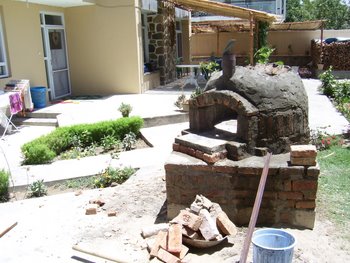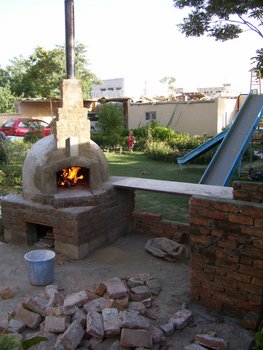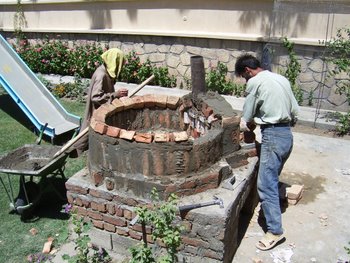|
Pizza Oven in Afghanistan
Building your own pizza oven is a great investment of time and money, not to mention the "cool" factor of having your own pizza oven in your own yard. My husband and I have overseen the design and construction of two of them in Kabul in the past few years. We've improved on the second one quite a bit. My husband has become an excellent pizza chef, a skill he didn't quite plan to acquire when we came to Afghanistan, but one our family, Afghan friends, and expatriates have quickly grown to appreciate. We found that throwing a pizza party quickly breaks down many cultural barriers and people begin to relax and chat. Here are his directions to get you started: While it is true that many pizza oven construction materials are not available in Afghanistan, the benefits of inexpensive materials and labor far outweigh the challenges associated with building your own pizza oven. Because Kabul is such a comfortable location for outdoor cooking and dining, you may choose to have other outdoor kitchen elements like countertops, shelves, grills and tables constructed at the same time. Have fun dreaming up your own design for those other parts… we’ll just be focusing on the oven. The Pizza Oven is comprised of the following basic components: The Stand Your oven enclosure rests on a traditional wire mesh reinforced 5 1/2 " concrete table. A square that is 5’x5’ and stands 4’ high will be a sufficient foundation for the oven dome. You will need to reinforce the floor with steel angle iron or even metal pipe material, anything to help support the weight of the oven. The Cooking Surface and Vent Floor Pizza is baked directly on the oven cooking surface. The oven landing sits just in front of your oven, under the vent. For our cooking surface and landing we used 1” thick marble tiles. Because these tiles can eventually wear out, we recommend that they be fitted together and set on a thin layer of sand, and not mortared in place, so they can be easily replaced.
The oven chamber is topped with a circular parabolic dome built from brick, an insulation blanket, wire mesh, and finally, cement. The dome is designed to efficiency absorb heat from a wood fire, and to evenly reflect stored heat, and heat from a live fire inside the oven, to the cooking surface. The mass of the dome provide a majority of the oven's ability to hold heat, and will allow the oven to deliver the high temperatures that are needed for cooking pizza. We found that a good arch for the dome was achieved by constructing the wall with a foundation layer of bricks standing upright. After that, subsequent layers of brick should be applied in the traditional horizontal orientation while radically directing the wall toward the center of the oven in an arch. Many Afghan masons may be confused with what you have asked them to construct, but they will likely be familiar with the building technique. It is similar to how some domed dwellings are constructed in parts of the country. Vent Unlike a tandoor oven, where the chimney is in the center, the brick oven's vent and chimney are outside of the oven -- in the front. We used a simple locally available stove pipe to serve as the beginning of our oven vent. 
Vent Arch and Door Your oven has two openings: one into the oven itself, and a second, optional opening around the oven vent and landing. Either or both can be decorated with a brick arch. For most installations, the opening into the oven itself can be built using standard angle-iron, producing a rectangular opening.You can easily have a door constructed at the local metal bazaar, but we found that it is not so necessary for pizza baking. We did use the oven to bake our turkey for our celebration of American Thanksgiving, and we found the results to be very delicious! My wife's chocolate chip cookies were absolutely fantastic baked in this oven. Just a few minutes resulted in perfectly crisp on the outside and gooey on the inside. The door is critical if you plan to use the oven for other baking needs besides pizza. Chimney We used 10’ of typical chimney pipe for our chimney. Dome Insulation After the oven elements have been assembled, the oven is covered with fiberglass insulation. Unlike thermal mass, where too much can be a bad thing, there isn't really such a thing as too much insulation. We used wire mesh to cover the fiberglass and provide a surface where the final layer of cement could hold to. Finish Before you use the oven, it must be cured slowly. It will probably crack if you fire it up to full temperature right away. We lit fires for 6 days in a row, gradually increasing the size and temperature. Contact me if you have more questions about any of this!
|

 The Oven Dome
The Oven Dome